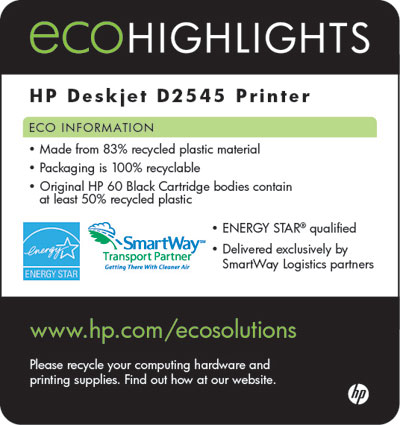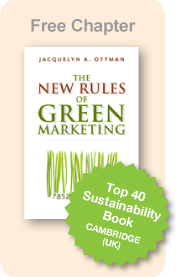Jacquie Ottman's
Green Marketing Blog
Alternatives to Eco-Labels
June 29, 2009 by Jacquelyn Ottman
Eco-labels are a popular and effective way to certify that a product really is as green as it claims to be. But what are some alternatives to eco-labeling, and what are the benefits of steering away from third-party certification? By Jacquelyn Ottman, with Sarah McGrath
Congratulations! You have a shiny new green product and you want to market it the right way. You worked hard to make it state-of-the-green-art – and you want people to believe that the product really is as green as you claim it to be. You naturally think of going the eco-labeling route, but stop. Unless it’s required by certain retailers or other customers, it may not be necessary. There are plenty of alternatives (as well as complements) to pursuing certification from a third party, no matter how trusted or well-known that third party is among even the greenest of consumers.
Eco-Labels: Benefits and Pitfalls
An eco-label is granted by a third party to certify the green-ness of any aspect of a product (single attribute label) or its entire life cycle (multi attribute label), including how it is produced (no CFCs), to the materials it uses (recycled, renewable), to where it goes after disposal (compostable). Eco-labels can be issued by government (EPA’s Energy Star, USDA’s Organic), environmental groups (FSC), NGOs (UL, GreenGuard), or trade associations (USGBC, creators of the LEED program).
Eco-labeling can be pretty useful. In a 2007 BBMG poll, 50% of consumers surveyed said that they believe a claim that is accompanied by an eco-label.
But you may want to think twice before pursing an eco-label, for several reasons. EPA’s Energy Star is free (though testing is necessary), but MBDC’s Cradle to Cradle can be pretty pricey. There are 299 eco-labels out there, but few are widely recognized or associated with documentable purchase influence. Energy Star, USDA Organic, and FSC Certified are the most widely recognized eco-labels, but opting for some of the other 296 would require massive amounts of education to make sure consumers know what your label means. Space on a package is tight; you may need to use that space for other, more important messages. Finally, an appropriate eco-label may not exist for your product category. If you want to market a greener pair of shoes, for example, you may be out of luck.
All this raises the question: Are there any viable alternatives to using a third party eco-labeling organization? The answer is a resounding yes!
Alternatives to Third-Party Eco-Labels
Many things can substitute for or complement eco-labels. Here are a few.
1. Follow the FTC Green Guides. The FTC has issued Green Guides that, if followed, can ensure that you provide clear, credible communication for just about any green marketing claim. The Guides are currently being updated to reflect terms new to the sustainable branding vernacular such as “carbon offsets,” “renewable,” and “sustainable,” so watch out for new definitions expected later this year.
2. Your Own Good Name. Companies that have a good reputation (e.g., Tom’s of Maine, Seventh Generation) don’t use eco-labels because they don’t need to – their product offerings and corporate reputations speak for themselves.
3. Third Parties. Get your claims verified by a trusted third party. Our client, ULEnvironment, can assess your claims, ingredients, and operations, and attest to what you say is true.
4. Transparency. When companies voluntarily disclose their ingredients, it shows that they have nothing to hide and trust is established. Tom’s of Maine lists all the ingredients on the side of their toothpaste cartons, including the source, and why that ingredient is used in the first place. SC Johnson’s Green List proactively discloses the ingredients used in its products and classifies those ingredients according to their impact on the environment and human health. Many Web sites, e.g., GoodGuide, rate consumer products – another opportunity to promote ingredient disclosure and raise the bar for competitors who won’t.
5. Leverage Awards You Have Won. If your company or product has been recognized by industry, government, or another group for its environmental achievements, let consumers know about it. For example, the Toyota Prius has never been certified with an eco-label, though in introducing the Prius, Toyota ran ads touting the fact that their new offering “has been honored by the United Nations, the Sierra Club and the National Wildlife Federation.” Over the course of the Prius’ seven-year history, Toyota has also been quick to tout such accolades as Motor Trend “Car of the Year” in 2004 and JD Power and Associates’ “Most Dependable Compact Car” in both 2008 and 2009.

6. Consider a Self-Declaration. Representing a growing trend in the electronics industry to complement Energy Star and EPEAT certifications, many companies, especially multinationals for whom eco-labels can represent cost and logistical nightmares, have developed their own programs to underscore the green-ness of their products. Examples include: HP’s “Eco Highlights,” Samsung’s “Eco-mark,” and Panasonic’s “eco ideas."
Click here to join our mailing list



 ShareThis
ShareThis

